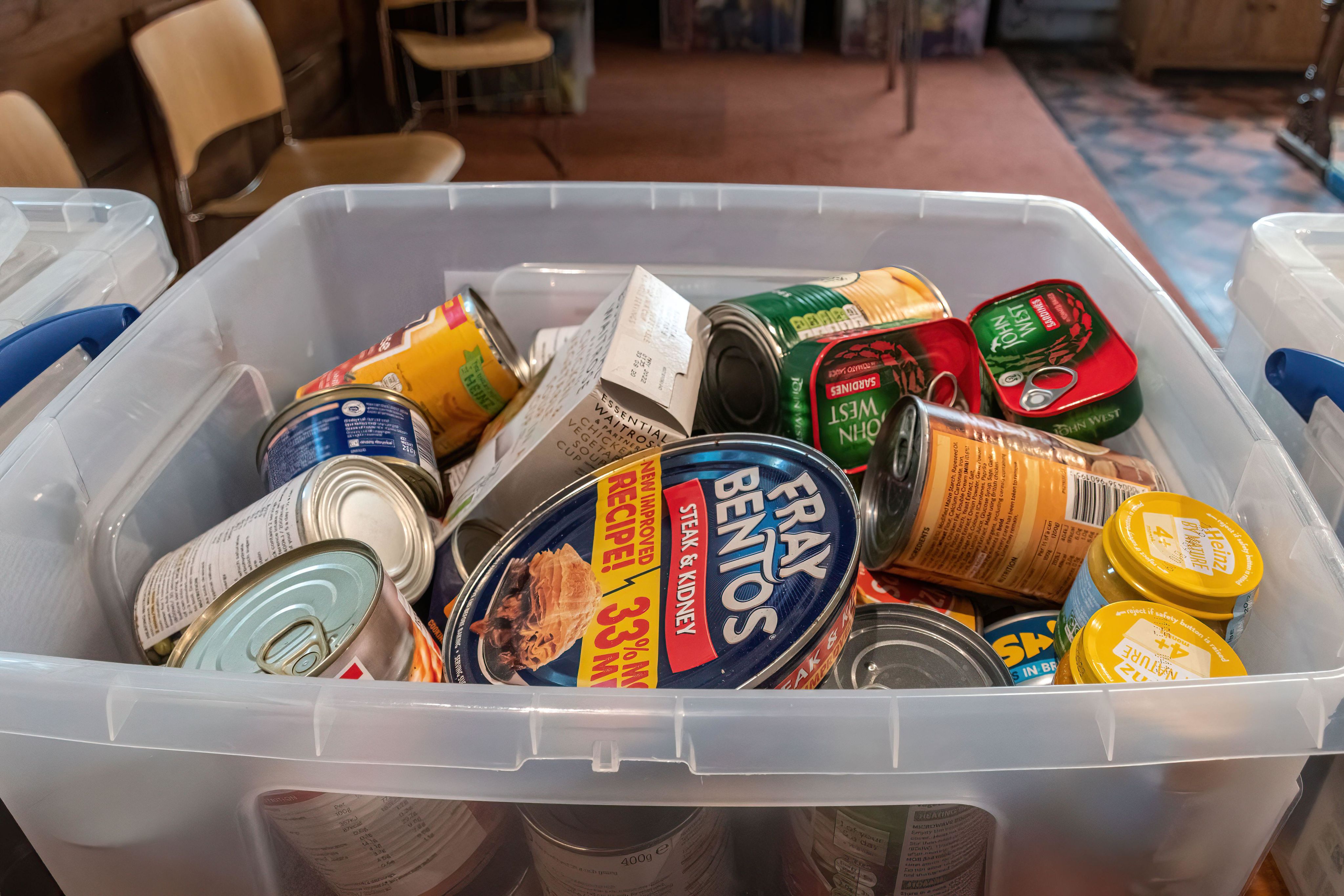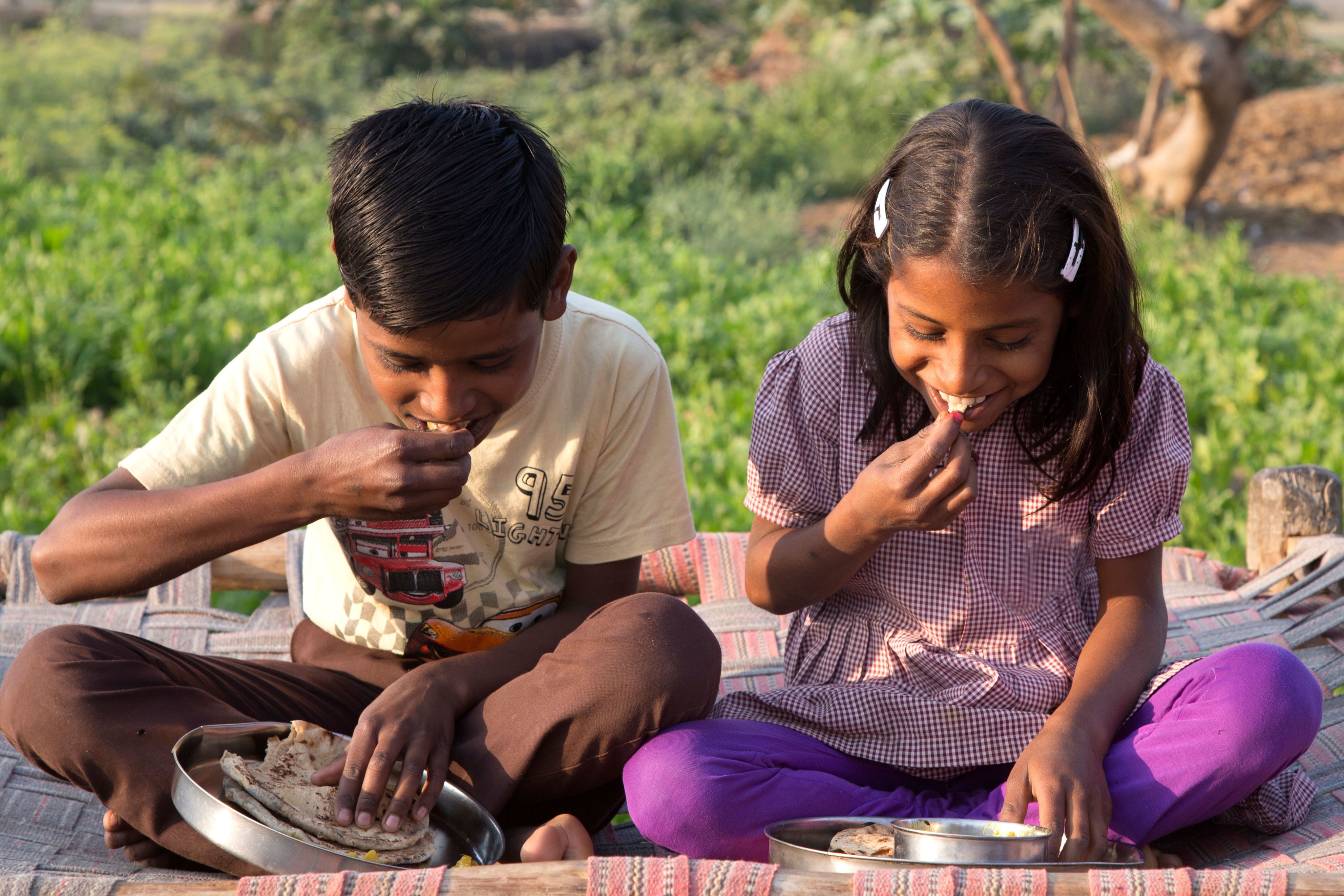Confronting child hunger
Effects and causes of food insecurity in children, plus strategies to end it

The United Nations (U.N.) aims to help end global hunger by 2030.
Yet its 2022 report on food security and nutrition says we're moving backward from this target.
Access to nutritious food is particularly important in childhood, when children's bodies and minds are developing, and they're more vulnerable to disease.
But children are still going hungry or not getting the nutrients they need.
And this isn't an issue that only affects low-income and developing countries. For instance, community food banks that supply donated food have existed in the U.K. since at least the 1990s, while food poverty has long been part of public debate in the U.S.
In this article, several leading experts highlight the causes and effects of child hunger, and examine strategies for ending food insecurity in children. We also look at the relationships between hunger, malnutrition, and obesity.

Key points
- Child hunger includes the physical sensations of hunger as well as malnutrition and food insecurity
- Weight gain and obesity can be symptoms of hunger and food insecurity, especially in high-income countries
- Hunger, malnutrition, and food insecurity affect children socially, mentally, and physically
- Adults and wider society are also affected by child hunger
- Poverty is a primary driver of child hunger in lower-income and higher-income countries but there are multiple causes in many regions
- Experts say recognizing food as a basic human right, more effective distribution of wealth, innovations in farming, better education for parents, and region-specific interventions could all help end child hunger
What is child hunger?
Hunger is defined by the Food and Agriculture Organization (FAO) of the U.N. as "an uncomfortable or painful physical sensation caused by insufficient consumption of dietary energy."
But children who experience hunger won't necessarily experience these physical sensations.
"Hunger is a 'fuzzy' concept, and not easily measurable meaningfully," says Dr. Francis Andrianarison, Senior Economist at the United Nations Development Programme (UNDP) and author of the article "Unravelling the linkage between food security, poverty reduction, and education for sustainable development."
"Child hunger can sometimes be thought of as childhood food insecurity," adds Dr. Michael Long, co-author of Holiday Hunger in the U.K. and Co-Editor of The Sociological Quarterly.
All hungry people are food insecure, but not all food insecure people are hungry
"There's a spectrum, from children just not having enough to eat of anything to children having some food, but the food they have access to might be largely from donated sources like food banks," says Dr. Claire Thompson, Reader in Food Inequalities and Health in the Department of Health and Social Work at the University of Hertfordshire, and co-author of Food Deserts and Food Insecurity in the U.K.
"This may not be of good quality or very fresh. And it might be high in salt, fat, and sugar and in some cases might even be unsafe food."
Hunger vs. malnutrition
This example of food lacking in nutrients highlights the link between hunger and malnutrition.
"Malnutrition is – as the name suggests – not getting the right kind of nutrients," says Dr. Dianna Smith, an Associate Professor in the School of Geography and Environmental Science at the University of Southampton, and co-author of Food Deserts and Food Insecurity in the U.K.
There's a kind of obesity/malnutrition paradox
"All hungry people are food insecure (malnourished), but not all food insecure (malnourished) people are hungry," adds Dr. Andrianarison.
"To provide enough food for children, some parents must rely on calorie-dense, processed foods that, while temporarily alleviating the feeling of hunger, do not provide adequate nutrition," says Dr. Long.
"So you can fill up your tummy on things like potatoes and rice and all sorts of especially starchy foods, which tend to be a lot cheaper," adds Dr. Smith.
"But they're not going to give you the kind of wonderful nutritional value of a diet full of fresh or frozen fruits and vegetables."
Linking hunger and obesity
This is why hunger and food insecurity can lead to weight gain and obesity in some households, particularly in high-income countries.
"There's a kind of obesity/malnutrition paradox," says Dr. Thompson.
"You can have too many calories. You can be obese. But you can also be lacking in nutrients because most of the food you have access to is energy-dense, but it's nutrient-poor."
"If we see someone who's bigger, we wouldn't associate that with a lack of nutrients. But it can be that, and that makes it a bit of a thorny issue – to say that a person who's overweight hasn't got good enough food can feel counterintuitive."
Child hunger statistics
- Globally, more than 1 in 5 children under 5 years old are stunted, which is often a sign of long-term malnutrition
- Almost 9 in 10 stunted children (89%) are from low-income and lower-middle-income countries
- Almost 8 in 10 overweight children (77%) are from lower-middle-income or upper-middle-income countries
- Around 45% of deaths in children under 5 years of age are linked to malnutrition
- 1 in 4 South African households reported running out of money for food in 2018
- In 2019, around 2.4 million U.S households with children experienced times when children were inconsistently fed or inadequately nourished
- There are more than 2,500 food banks in the U.K.
- Meanwhile, the U.K. throws away almost 10 million tons of food a year

Impacts of child hunger and food insecurity
Child hunger has many short-term and long-term impacts. And it's not just kids and their parents and carers who are affected – there are societal repercussions too.
Effect on children
Hunger, malnutrition, and food insecurity affect children socially, mentally, and physically. They also affect the quality of their education and learning.
Physical health
A negative impact on physical health is an obvious symptom, as Dr. Andrianarison highlights:
"Wasting is the most prevalent, acute, and potentially fatal manifestation of malnutrition. Children suffering from wasting are underweight and have weakened immune systems, which exposes them to the risk of developmental delays, sickness, and mortality."
There are longer-term consequences for children's physical health too, especially in high-income countries where children are eating foods high in calories but low in nutrients to stave off hunger.
We know that children who are obese are more likely to become obese adults
"If children are hungry and malnourished, you're more likely to see excess weight, poor quality diet, and poorer health outcomes linked to diet in the immediate term and long term," says Dr. Smith.
"We know that children who are obese are more likely to become obese adults," she adds.
This can lead to other health complications when children reach adulthood, such as type 2 diabetes and cardiovascular diseases. Some children are even developing serious health issues before they become adults.
"In richer countries, we are seeing type 2 diabetes more often in children now," highlights Dr. Smith.
Social and psychological effects
Hunger and food insecurity can lead to social isolation, says Dr. Long:
"Many activities that children partake in, such as play dates with other children, involve food. A food insecure household cannot afford to invite their children’s friends over to play because there is usually an expectation of snacks or meals being provided."
Meanwhile, the stigma of qualifying for aid can make the problem of child hunger worse in regions where it affects smaller groups of the population.
"An example would be children who qualify for free school meals because their household income level is below a certain threshold," says Dr. Long.
"However, they do not take advantage of the free lunch because they don’t want to be identified and labeled as 'poor.' They forgo eating, rather than potentially exposing themselves to the stigma that comes with being poor."
Hungry children have shorter attention spans and less ability to concentrate compared with non-hungry children
"Hunger and food insecurity are really corrosive for your well-being," adds Dr. Thompson.
"If you're worrying about where your food's going to come from, you can't enjoy it."
Learning and education
Hunger and food insecurity significantly affect children's education.
"Research frequently has shown that hungry children have difficulty in school and do worse on a number of educational metrics compared to students who do not suffer from food insecurity," says Dr. Long.
"Hungry children have shorter attention spans and less ability to concentrate compared with non-hungry children. Hungry children simply do not ingest enough healthy calories for their bodies to function properly and therefore put them in a position to be successful in the classroom."
"This is why there has been so much movement in England to have more breakfast clubs and an increase in the provision of free school meals," adds Dr. Smith.
Effect on adults
Adults in a household are likely to feel the physical effects of food insecurity before the children, as Dr. Smith highlights:
"Parents will skip meals and cut back on the size of their own meals to reduce the impact on their children."
"This just shifts the hunger problem around the household, and there are many repercussions for adults and parents who are hungry," adds Dr. Long.
Psychological effects on adults
One repercussion is that adults may then experience similar mental health and well-being issues to their children, including anxiety and depression.
"There's a clear link between food insecurity and mental health in both children and adults," says Dr. Smith.
"In the research we do, parents will talk about how much they worry about their children's diet."
Reducing malnutrition is essential for accelerating economic growth
The stigma attached to food insecurity can also prevent adults from seeking help for their families.
"Sometimes, they're afraid to ask," says Dr. Thompson.
"Wouldn't you be a bit scared if you went to a social worker or a teacher or a doctor and said, 'I can't feed my kids?' There's that fear that someone will take them away and that's quite powerful."
Effect on society
The direct impacts of hunger and food insecurity on children and adults lead to longer-term indirect effects on society.
These include the costs of treating associated health conditions such as tooth decay, obesity, and diabetes, as well as the effects of any disruption to children's learning and education.
"Reducing malnutrition is essential for accelerating economic growth," says Dr. Andrianarison.
"At the country level, malnutrition affects human capital and results in loss of productivity that delays national development."

Hunger and risky behaviors
A 2022 study by Kathryn L. Krupsky et al. examined associations between hunger in adolescents, health risk behaviors, and adverse experiences.
It found that high school students in the U.S. who have experienced hunger are:
- 2.2 times more likely to smoke cigarettes
- 2.8 times more likely to have sexual intercourse for the first time before the age of 13 years
- 2.6 times more likely to have been raped
- 2.4 times more likely to experience dating violence
Causes of child hunger and food insecurity
There are many factors that contribute to childhood hunger and food insecurity.
"Hunger is a symptom of all sorts of systems going wrong," says Dr. Thompson.
Poverty
"Hunger and malnutrition are frequently linked to poverty," says Dr. Andrianarison.
Dr. Long highlights how economic systems can be a primary cause of poverty:
"The global economy can be considered a version of neoliberal capitalism, which favors little government intervention in the economy.
"Frequently in high-income countries, this includes the rollback or elimination of social programs for the poor. These programs often include those that provide food assistance to households in need. Food assistance is often left to charities and volunteers, which can be hit or miss, depending on where you live."
"In high-income countries, it's not that there's a lack of money or food. It's the distribution of wealth and distribution of food that's the problem," adds Dr. Thompson.
This leads to situations where it's difficult to cook or store staple foods.
"If you can't pay for gas or electricity, you won't cook anything or fill your freezer. If you're in temporary accommodation for 18 months with just a kettle and a microwave, what do you do?
"In that context, buying things like takeaway chips or eating at the chicken shop makes a lot of sense."
Food assistance is often left to charities and volunteers, which can be hit or miss, depending on where you live
Are economic systems an influence in lower-income regions too?
"In low-income countries, neoliberal capitalism has created a well-documented, export-oriented agribusiness model wherein food is primarily produced as a commodity to be sold for money, rather than to feed and nourish the individuals – and their local communities – who produce it," says Dr. Long.
"Childhood and household food insecurity often result from this export-oriented model, as agricultural products, which were grown to feed the local population in the past, have given way to specialty crop production – coffee, tea, etc – for trade in international capitalist markets."
Multiple causes
Dr. Andrianarison highlights further causes of child hunger in lower-income regions, such as in Africa:
"Poverty remains one of the most significant causes of hunger in Africa, but climate change-related droughts in some countries like Ethiopia, Eritrea, Somalia, Madagascar, and Djibouti, military conflicts, and the COVID-19 crisis have significantly impacted living conditions, and ultimately led to people – especially children – facing hunger.
The war in Ukraine is having a particularly big effect, because the country produced one-tenth of the world's grain before 2022.
"Some countries also experience multiple shocks that aggravate the situation," adds Dr. Andrianarison.
"For instance, Madagascar is an extremely poor country with more than 92% of its people living on less than $2 a day. It has one of the highest rates of childhood stunting in the world.
"The situation in southern Madagascar, affected by drought, is catastrophic. According to UNICEF, at least half a million children under the age of 5 are acutely malnourished, including 110,000 in a severe state, suffering irreversible damage to their growth and development.
"Four consecutive years of drought have destroyed crops and cut off people's access to food."
Mental health
We've seen how hunger and food insecurity make mental health problems worse. But poor mental health in adults can also be a contributing factor to their children experiencing hunger in some regions, says Dr. Smith:
"It's a cyclical relationship where poor mental health can contribute to low income and food insecurity, while having low income and food insecurity contributes to poor mental health.
"It's quite a depressing cycle."
Proximity to food
In some regions, living in a "food desert" can be another cause of child hunger, food insecurity, and malnutrition.
Food deserts describe areas where there is poor access to healthy and affordable food. They are especially prevalent in rural and inner-city areas, and are more likely to affect low-income households, households with young children, households headed by women, and people of color.
However, food deserts can be hard to define, because what is affordable and accessible for one household may not be for another.
"There are differences in rural versus urban areas," says Dr. Thompson.
"In rural areas, it can depend on transport. If you haven't got a car, how do you access cheap food? Maybe the supermarket doesn't deliver. Maybe there are only two buses a day."
"If there is food there, it's really expensive," adds Dr. Smith.
"I did some work in the New Forest. This is a supposedly wealthy part of the U.K. yet 4% of residents used a food bank in 2020."
"We priced up the same basket of 20 basic food items, including staples like bread and milk, at all the stores we could find in the New Forest.
"The total cost varied from £16 at a national chain supermarket to £38 at a smaller branch of the same chain.
"That's more than a £20 difference. If you only have access to the smaller shop, that's clearly a food desert."

Is there a link between malnutrition and parents' level of education?
The FAO reports that stunted children are more likely to live in rural areas in low-income or lower-middle-income countries and have mothers with no formal education (the FAO report doesn't mention fathers' education status).
This study, which examined malnutrition among children under 5 years old in Ethiopia, also highlights links between education level and malnutrition.
It found that children born into informally educated families and families who cannot read or write were four times as likely to be stunted and twice as likely to develop wasting compared with children born into university-educated or college-educated families.
This study of infants in India found that lack of maternal education was a possible factor in stunting in babies, along with the delayed introduction of complementary foods, and lower household wealth.
Ending child hunger
With many causes that differ by region and population group, ending childhood hunger and its associated issues is a substantial challenge.
"Beyond the emergency actions of food distribution, addressing the structural problems remains a long-term solution," says Dr. Andrianarison.
Food as a basic human right
"Governments and international policy organizations need to be more involved in childhood/household hunger," says Dr. Long.
"'Food security,' or the absence of hunger, should be a basic human right that is guaranteed for all people of the world.
"There have been attempts at codifying the right to food in international policy documents – e.g. the International Covenant on Economic, Social and Cultural Rights. Some countries have ratified this document, while others have not.
"However, even those countries that have ratified this document, such as the U.K., still have sizable levels of childhood and household food insecurity in the population.
Food security should be a basic human right
"Countries need to take the argument that food is a basic human right seriously, rather than just paying it lip service."
Regional interventions
Governments and policymakers need to deal with specific causes to deal with child hunger on a regional or national level.
For example, in an article co-authored with Cyrille Bergaly Kamdem and Blaise Che Kameni, Dr. Andrianarison highlights how technological innovations in farming, coupled with investment and training, can help ensure food security in Cameroon.
"We don't have a real national policy to address food insecurity in the U.K.," adds Dr. Smith.
"This means the responses to food insecurity are done at the local level, largely through charitable sector organizations like food banks.
"Local governments are doing their best with food clubs and free school meal provision. But it's a 'postcode lottery' in terms of what opportunities you have for more affordable food, what supermarkets there are, and what support there is for families who might need more help."
Dealing with the distribution of wealth
It's also clear that any interventions to tackle child hunger must tackle poverty.
"In the immediate term, we need more equal distribution of wealth, like better welfare systems and more secure, affordable housing systems," says Dr. Thompson.
"We need to create more opportunities for people to engage in the workforce through better and affordable childcare. And we need better support for mental health for everyone, including children," adds Dr. Smith.
Nutrition education and knowledge
Dr. Smith adds, however, that tackling child hunger isn't just about giving more people money:
"It's also making sure people have the resources to use that money to the best of their abilities, and thinking creatively around things like more community engagement.
"If you're on a low budget and you're not confident about cooking, you're not going to spend money on things that your kids won't eat or you're not sure how to prepare.
"You see really positive outcomes from food clubs, because the kids are willing to try new fruits and vegetables, for instance.
"It would be great to see more cooking education in schools too."
We need more equal distribution of wealth, like better welfare systems and more secure, affordable housing systems
Education may play an important role in lower-income regions too, such as in sub-Saharan Africa, says Dr. Andrianarison:
"Education is important to improve agricultural productivity, but mothers’ nutrition education is also important in enabling access to sufficient quality and quantity of food for children.
"African governments need to incorporate nutrition into agricultural policy, rural development plans, social policy, and basic and adult education."
Further reading:
Journal articles
- Beyond groceries: an analysis of referral needs to address underlying causes of child hunger among households accessing food pantries by Marianna S. Wetherill et al. in Social Work in Public Health
- Combating food insecurity and creating sustenance: addressing the root causes of hunger in the US through political empowerment and public policy engagement by Adam Pine in Local Environment
- Estimating true demand at hunger relief organizations with predictive modeling by Kehinde Odubela, Steven Jiang, and Lauren Davis in the Journal of Hunger & Environmental Nutrition
- Household food insecurity in an urban food desert: A descriptive analysis of an African American community by Robert Emmet Jones et al. in the Journal of Hunger & Environmental Nutrition
- Political commentary on world hunger triggered by war in Ukraine by Yuriy Skorokhod et al. in the International Journal of Environmental Studies
- Unravelling the linkage between food security, poverty reduction, and education for sustainable development by Francis Andrianarison in The Journal of Development Studies
Books
- Child Hunger and Human Rights: International Governance by Clair Apodaca
- Food Deserts and Food Insecurity in the U.K.:Exploring Social Inequality by Dianna Smith and Claire Thompson
- Economics of Feeding the Hungry: Sustainable Intensification and Sustainable Food Security by Noel Russell
- Holiday Hunger in the UK: Local Responses to Childhood Food Insecurity by Michael A. Long, Margaret Anne Defeyter, and Paul B. Stretesky
- Hunger and Poverty in South Africa: The Hidden Faces of Food Insecurity by Jacqueline Hanoman
You might also like:
Social justice and sustainability
Find out about the content we publish, commitments we've made, and initiatives we support related to social justice and sustainability:
 China
China Africa
Africa
